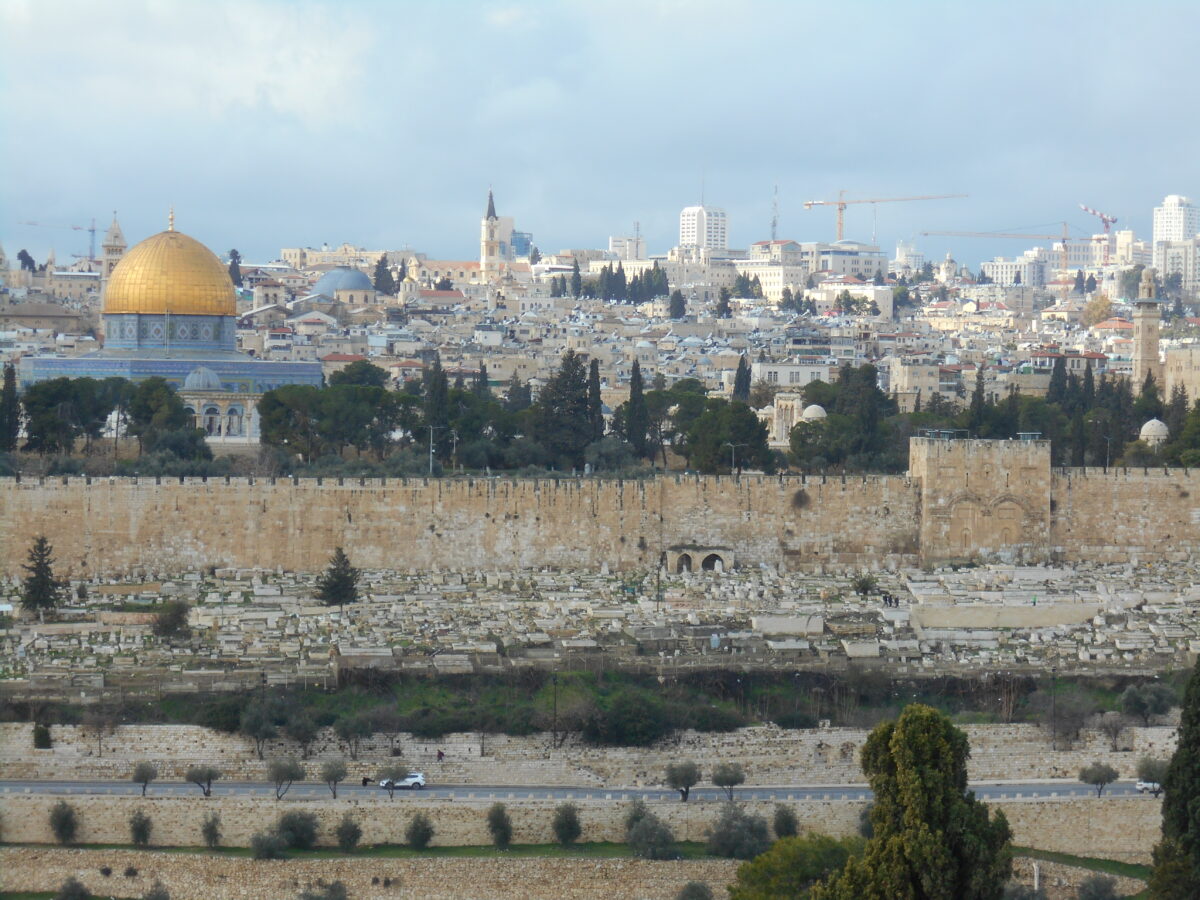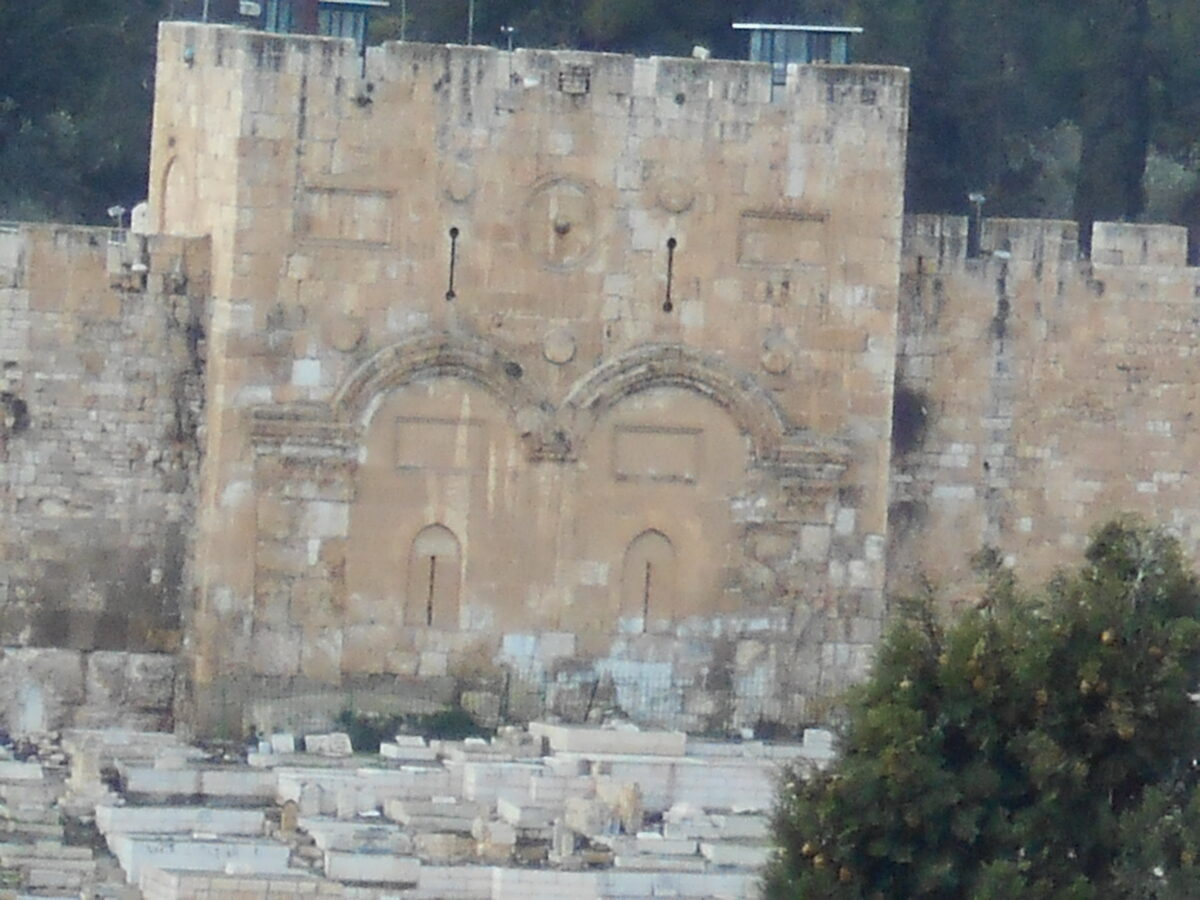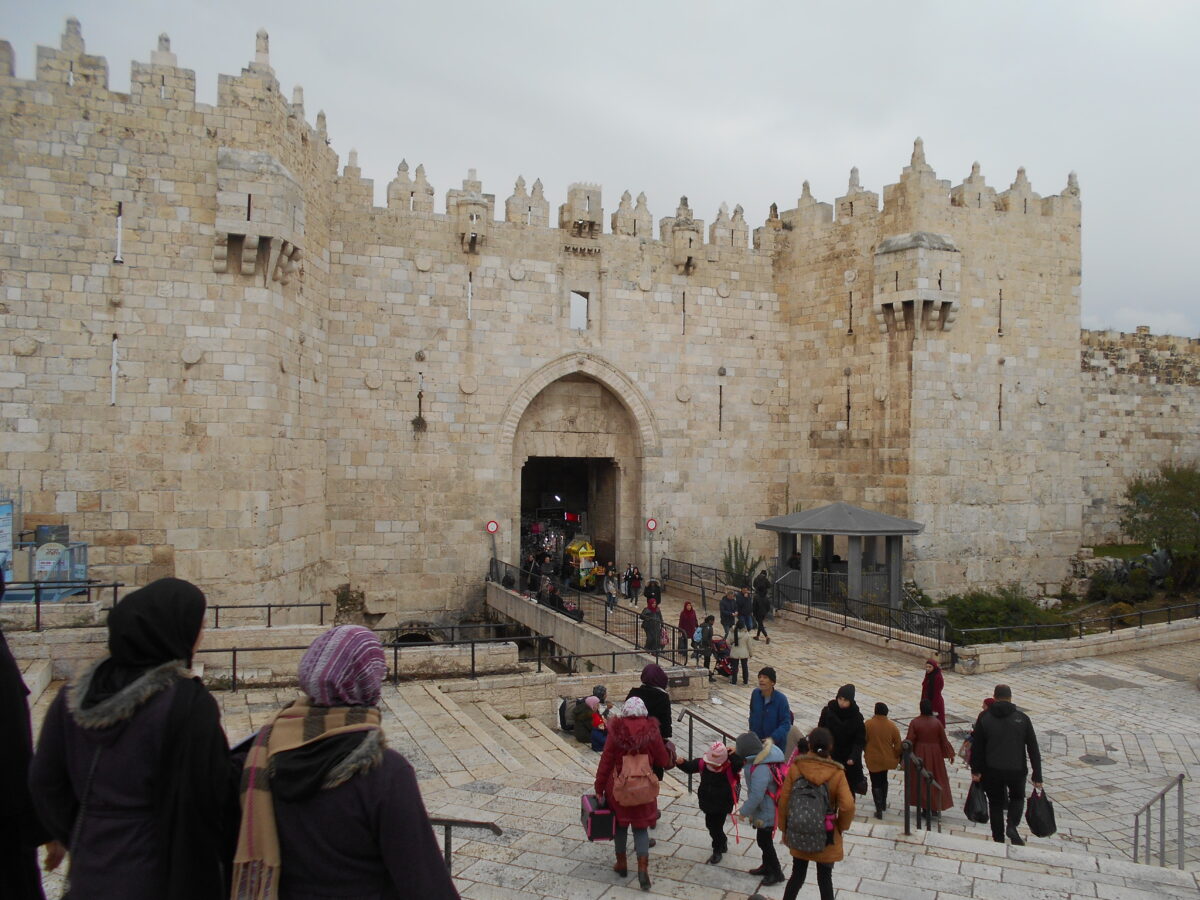By Sr. Elizabeth Ann
Zech 9:9-10 Psalm 24 Phil 2.5–11 Mk 11:1-11
PSALM 122
1 I was glad when they said to me, “Let us go to the house of God.”
2 Now our feet are standing within your gates, O Jerusalem.
3 Jerusalem is built as a city that is at unity with itself.
4 To which the tribes go up, the tribes of God, the assembly of Israel, to praise God’s holy Name. Amen.
Psalm 122 is one of the Psalms of Ascents. It is a psalm that pilgrims recite as they approach Jerusalem, as indeed my brother and I did in January 2020 in the taxi cab on our way from the airport in Tel Aviv to begin our pilgrimage to the Holy Land. After attending Evening Prayer at St. George’s Cathedral, we walked along Nablis Road towards the walls surrounding the Old City and approached Damascus Gate. The gate is huge and people look small as they walk towards, then beneath the gate.
According to the stories we have about his early years from the gospel of Luke, Jesus had been going up to Jerusalem from his infancy. The gospels of Matthew, Luke and John all have stories which place Jesus in Jerusalem and within the temple prior to his Palm Sunday entry. Mark’s gospel focusses on Jesus’ ministry in Galilee and point towards this first entry into Jerusalem. When he arrived there with the disciples and immediately went up into the temple, Jesus looked around at everything, but because it was late, he left and went back to Bethany with the disciples. The whole point is the dramatic entry, not the actual visit to the temple.
The Gates by which one enters the Old City of Jerusalem, are spaced around the walls of Jerusalem. They are not the same gates as would have existed in Jesus’ time as the gates themselves kept being torn down and rebuilt over the ages, but they certainly give a feel for what the entrances to the city were like. They would have been big enough for foot traffic, pack animals, and carts for carrying goods and people into and out of the city. The gates in the walls were also for protection for those within in times of trouble and distress. Up on the Mount of Olives, looking back towards the city of Jerusalem across the Kidron Valley, one sees the wall which surrounds the old city of Jerusalem. On the East wall underneath the site of the temple rock where the Dome of the Rock is now situated is an ornate double gate completely bricked up. It is known variously as the Golden Gate, the Mercy Gate, or the two sides of the gate taking the names of Mercy and Repentance. This Eastern most gate of the city is supposed to be the gate through which Jesus passed on Palm Sunday because it led directly to the Temple Mount. It is also supposed to be the gate through which the Messiah will return and enter Jerusalem again.
“Lift up your heads, O gates; lift them high O everlasting doors; and the One who reigns in glory shall come in.” Why would the psalmist instruct the gates and doors to lift up their heads? To be lifted high? I remember Br. Dunstan, SSF (of blessed memory) telling the story about how he had flown a plane during the Second World War underneath the Golden Gate Bridge in the San Francisco Bay, passing below the span of the bridge and above the water. Bridges need to be built high enough for ships to pass safely beneath while ensuring the traffic on the bridge is also accommodated. There are lift bridges, draw bridges, and swing bridges, all methods of making it possible for larger ships to pass through a low span; but mostly bridges are simply built as tall as possible to accommodate anticipated water traffic sailing safely beneath. “Lift up your head, O gates,” gives the impression that the One who reigns in glory, God, will not fit through our mortal gates and doors, so the gates and doors need to be opened upwards, higher, taller, heavenward. If the gates and doors are looking down, then they are looking down on all those who pass beneath their lintels.
Marcus Borg and John Dominic Crossan, in their book, The Last Week: What the Gospels Really Teach about Jesus’ Final Days in Jerusalem, write about two processions entering Jerusalem on that Palm Sunday, the beginning of Passover. Entering from the west was Pontius Pilate, the Roman governor who would have entered Jerusalem with soldiers and cavalry and blatant displays of Roman imperialism. The soldiers would be there to keep the peace during the Passover. Pilate’s procession proclaimed Roman Empire and occupation. From the East Jesus enters and goes directly to the temple with a crowd of peasants. Jesus’ procession proclaimed an alternate vision in the reign of God.
There were probably some crowds who attended the Roman procession, but I expect they were somewhat subdued in their enthusiasm for their oppressors coming into the holy city during Passover. The crowds who gathered around Jesus, sound more enthusiastic with the waving of palm branches and shouting their loud “Hosannas.” These were Jesus’ people: the poor and marginalized, the disenfranchised, the outcast and the lowly, who saw in Jesus’ alternate vision of the reign of God a place for themselves; where love, justice, and mercy are practiced and accessible for all.
Jesus’ entrance into Jerusalem was a statement—a parable in action. In our daily office readings recently, we heard Jeremiah being told to visit a potter and watch the potter work the clay. It was a graphic illustration of the word God wanted Jeremiah to relate to the people. Drama can help us more readily understand and therefore accept the word of God. It’s why so often Jesus told stories to illustrate his message. Jesus’ entry into Jerusalem was a dramatic representation of the prophecy in Zechariah; proclaiming his entry into the holy city as Messiah, the holy one of God; not as empire, but humble and lowly, riding on a donkey – not with military might but in peace. Jesus had told the disciples to go to obtain the young donkey for the procession. People joined the procession, or as Borg and Crossin suggest, the protest march. Who doesn’t love a parade? The people who joined the procession would have known the messianic prophecies from Zechariah and from the Psalms, especially Psalm 118, which we use during Eastertide at the Saturday night Vigil of the Resurrection, where we get the words for the Hosanna.
25 Hosanna, sing hosanna! God, send us now success.
26 Blessed is the One who comes in the name of God; we bless you from the house of God.
27 The Holy One has shined upon us; form a procession with branches up to the horns of the altar.
They shouted Hosanna, and waved palm branches, and threw them down on the road along with their cloaks to pave the way for Jesus’ triumphant ride into Jerusalem. When I’d visit my Uncle on his farm, we’d often go out for a drive. On the gravel roads we’d kick up a lot of dust behind us. Some sections of the road had been coated with an oil treatment which kept the dust down, but “only around those farms,” my uncle would comment, “who had paid their taxes!” People put their cloaks and palm branches down on the road to keep the dust down. Doing so meant that everyone could clearly see Jesus riding on the donkey, with those in procession waving palm branches heading towards the temple. I don’t think Jesus was a particularly tall man. When he was speaking to crowds, he had to stand up higher on a hill, or sit on the edge of a boat put out a little on the water to be seen and heard. A standard donkey is between 90 to 120 cm (36 and 48”), so a person sitting on one wouldn’t have been much taller than people simply walking. Likely Jesus wouldn’t have had to duck his head, even sitting on the back of a donkey, to enter through the gates of Jerusalem. The Romans entering along a dusty road from the west, may have had to lower their imperial standards as they passed through the gates, and those sitting on horses may have also had to bow their head to enter. As Jesus passed through, humble and riding on a donkey, the head of the gates looked down on the Messianic procession of a people’s king, proclaiming the reign of God.
The kenotic passage from Philippians in referring to Christ, “who, though he was in the form of God, did not regard equality with God as something to be exploited, but humbled himself and became obedient to the point of death— even death on a cross,” goes on to say, “therefore God also highly exalted him.” Perhaps it is a good thing that the Eastern most gate in the wall around the Old City of Jerusalem, the Golden Gate, is bricked up so no one can enter there. Let the one who reigns in glory enter. Christ enters humbly into our hearts, not requiring lofty gates and ornate doors, only our willingness to open them to God’s love. This holy week, as we walk through the days and read and hear the dramatic events unfold again, there is not need of looking outwardly, upwards, higher for one who comes in glory. Simply open the golden gates and doors of your heart for Christ to enter humbly in love to bring the reign of God’s justice and mercy, love and peace.
6 Pray for the peace of Jerusalem: “May they prosper who love you.
7 Peace be within your walls and quietness within your towers.
8 For my kindred and companions’ sake, I pray for your prosperity.
9 Because of the house of our God, I will seek to do you good.” Amen.





